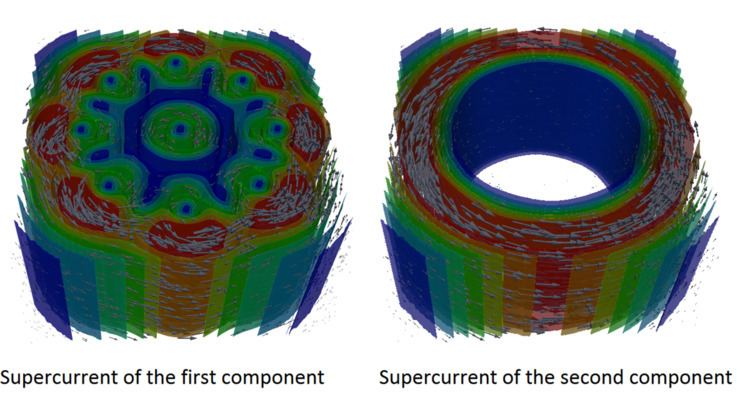 | ||
Type-1.5 superconductors are multicomponent superconductors characterized by two or more coherence lengths, at least one of which is shorter than the magnetic field penetration length
Contents
- Detailed explanation
- Type 15 superconductor in mixtures of independently conserved condensates
- Type 15 superconductivity in multiband systems
- Microscopic models
- Current experimental research
- Non technical explanation
- Animations of type 15 superconducting behavior
- References
Animation from numerical calculations of vortex cluster formation are available at "Numerical simulations of vortex clusters formation in type-1.5 superconductors."
Detailed explanation
Type-I superconductors completely expel external magnetic fields if the strength of the applied field is sufficiently low. Also the supercurrent can flow only on the surface of such a superconductor but not in its interior. This state is called the Meissner state. However at elevated magnetic field, when the magnetic field energy becomes comparable with the superconducting condensation energy, the superconductivity is destroyed by the formation of macroscopically large inclusions of non-superconducting phase.
Type-II superconductors, besides the Meissner state, possess another state: a sufficiently strong applied magnetic field can produce currents in the interior of superconductor due to formation of quantum vortices. The vortices also carry magnetic flux through the interior of the superconductor. These quantum vortices repel each other and thus tend to form uniform vortex lattices or liquids. Formally, vortex solutions exist also in models of type-I superconductivity, but the interaction between vortices is purely attractive, so a system of many vortices is unstable against a collapse onto a state of a single giant normal domain with supercurrent flowing on its surface. More importantly, the vortices in type-I superconductor are energetically unfavorable. To produce them would require the application of a magnetic field stronger than what a superconducting condensate can sustain. Thus a type-I superconductor goes to non-superconducting states rather than forming vortices. In the usual Ginzburg–Landau theory, only the quantum vortices with purely repulsive interaction are energetically cheap enough to be induced by applied magnetic field.
It was proposed that the type-I/type-II dichotomy could be broken in a multi-component superconductors, which possess multiple coherence lengths.
Examples of multi-component superconductivity are multi-band superconductors magnesium diboride and oxypnictides oxypnictide and exotic superconductors with nontrivial Cooper-pairing. There, one can distinguish two or more superconducting components associated, for example with electrons belong to different bands band structure. A different example of two component systems is the projected superconducting states of liquid metallic hydrogen or deuterium where mixtures of superconducting electrons and superconducting protons or deuterons were theoretically predicted.
It was also pointed out that systems which have phase transitions between different superconducting states such as between
Type-1.5 superconductor in mixtures of independently conserved condensates
For multicomponent superconductors with so called U(1)xU(1) symmetry the Ginzburg-Landau model is a sum of two single-component Ginzburg-Landau model which are coupled by a vector potential
where
Type-1.5 superconductivity in multiband systems
In a two-band superconductor the electrons in different bands do not independently conserved thus the definition of two superconducting components is different. A two-band superconductor is described by the following Ginzburg-Landau model
where again
Microscopic models
A microscopic theory of type-1.5 superconductivity has been reported.
Current experimental research
In 2009, experimental results have been reported claiming that magnesium diboride may fall into this new class of superconductivity. The term type-1.5 superconductor was coined for this state. Further experimental data backing this conclusion was reported in . More recent theoretical works show that the type-1.5 may be more general phenomenon because it does not require a material with two truly superconducting bands, but can also happen as a result of even very small interband proximity effect and is robust in the presence of various inter-band couplings such as interband Josephson coupling. In 2014 experimental study suggested that Sr2RuO4 is type-1.5 superconductor
Non-technical explanation
In Type-I and Type-II superconductors charge flow patterns are dramatically different. Type I has two state-defining properties: Lack of electric resistance and the fact that it does not allow an external magnetic field to pass through it. When a magnetic field is applied to these materials, superconducting electrons produce a strong current on the surface which in turn produces a magnetic field in the opposite direction. Inside this type of superconductor, the external magnetic field and the field created by the surface flow of electrons add up to zero. That is, they cancel each other out. In Type II superconducting materials where a complicated flow of superconducting electrons can happen deep in the interior. In Type II material, a magnetic field can penetrate, carried inside by vortices which form Abrikosov vortex lattice. In type-1.5 superconductor there at least two superconducting components. There the external magnetic field can produce clusters of tightly packed vortex droplets because in such materials vortices should attract each other at large distances and repel at short length scales. Since the attraction originates in vortex core's overlaps in one of the superconducting components, this component will be depleted in the vortex cluster. Thus a vortex cluster will represent two competing types of superflow. One component will form vortices bunched together while the second component will produce supercurrent flowing on the surface of vortex clusters in a way similar to how electrons flow on the exterior of Type I superconductors. These vortex clusters are separated by "voids," with no vortices, no currents and no magnetic field.
Animations of type-1.5 superconducting behavior
Movies from numerical simulations of the Semi-Meissner state where Meissner domains coexist with clusters where vortex droplets form in one superconducting components and macroscopic normal domains in the other.
